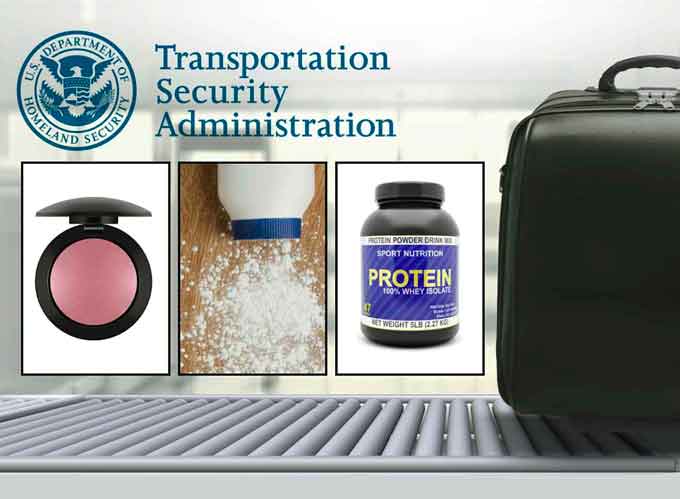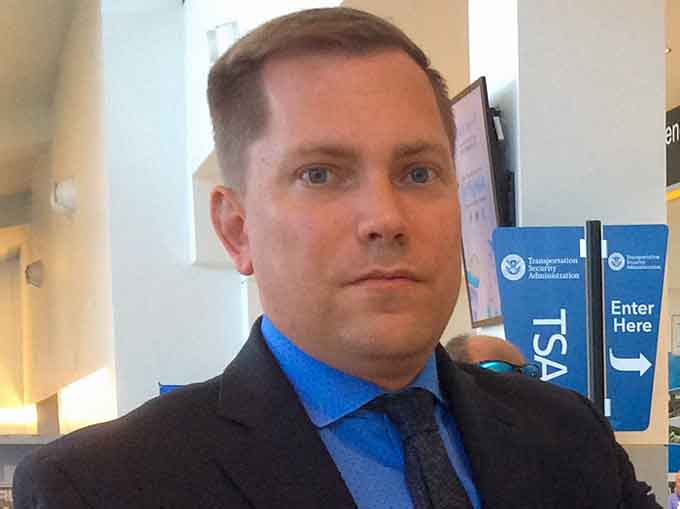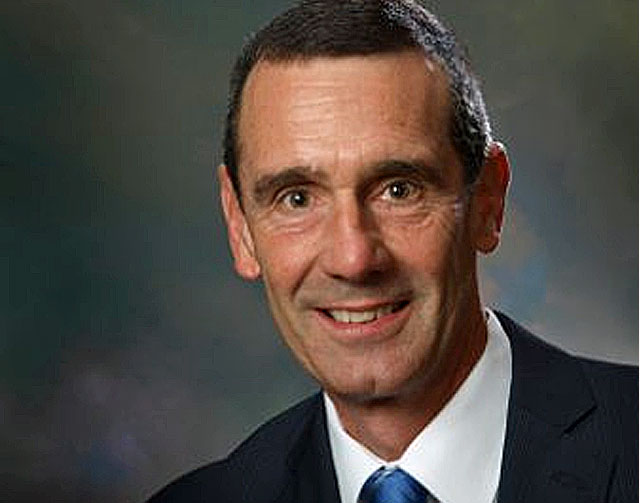
By Madison Park, CNN
If you’re traveling by plane with more than 12 ounces of cosmetics powder, dry spices, protein mix or talcum, you may want to check it.
That’s because the Transportation Security Administration has been taking a closer look at containers of powder that fit more than the volume of a standard soda can.
(Air travelers face a new level of attention at airport checkpoints. The TSA will now inspect passengers’ carry-on bags for powdered material, anything from cosmetics to drink mixes. Courtesy of CBS Morning News and YouTube. Posted on Jun 20, 2018.)
If packed in a carry-on bag, such containers could be subject to extra screening or banned from the airplane cabin.
If TSA officers can’t figure out what the powder is, it may be discarded or put into checked baggage.
To cut the risk of having items thrown out, the TSA encourages passengers to put powder substances of more than 12 ounces into checked bags.
The measure is security-related, the TSA says, as improvised explosive devices still pose a threat and as substances such as fentanyl or pepper spray, if released in flight, could harm passengers.
(Learn More. Fentanyl has become a true health threat to law enforcement and first responders protecting the communities we live and work in. Produced in collaboration with the Alliance to Combat Transnational Threats, this presentation shows a unique insight into the history, legitimate, and illicit uses of fentanyl, as well as giving practical precautions involving potential exposure risks. Courtesy of U.S. Customs and Border Protection and YouTube. Posted on Feb 4, 2018.)
The powders rule was part of expanded security measures that began last summer, TSA spokesman Michael England said.
In April, the agency said it had completed rolling out stronger regulations for carry-on screening, including the requirement to separate items such as foods and powders that could “clutter bags and obstruct clear images on the X-ray machine.”

The agency had warned that “items that cannot be identified and resolved at the checkpoint are prohibited from entering the cabin of the aircraft.”
The rule about powders also goes into effect on June 30 on international flights bound for the United States, England said.
“TSA is communicating with our international partners to ensure last points of departure airports align with pre-clearance requirements and our domestic procedures as part of our efforts to raise the global aviation security baseline,” he said.
CNN’s Rene Marsh contributed to this report.
Original post https://www.cnn.com/2018/06/20/politics/tsa-powder-carry-on-bags/index.html
Travelers are encouraged to organize their carry-on bags and keep them uncluttered to ease the screening process and keep the lines moving.

“I am committed to continue raising the baseline for aviation security, and these enhanced screening measures enable TSA officers to better screen for threats to passengers and aircrew while maintaining efficiency at checkpoints throughout the U.S.,” said TSA Administrator David Pekoske.
“Our security efforts remain focused on always staying ahead of those trying to do us harm and ensuring travelers get to their destination safely.”
The enhanced carry-on screening procedures have been phased in over the past several months in standard lanes at airports across the country.
Travelers may experience minimal changes to what can be brought through the checkpoint; food and liquid items that comply with the 3-1-1 liquids rule, electronics, and books continue to be allowed in carry-on baggage.
(You are allowed to bring a quart-sized bag of liquids, aerosols, gels, creams and pastes through the checkpoint. These are limited to 3.4 ounces (100 milliliters) or less per item. This is also known as the 3-1-1 liquids rule. Courtesy of the TSA and YouTube)
However, TSA officers may ask travelers to separate dense foods, powders and other items to allow screening officers to obtain a clear X-ray image for security purposes.
Items that cannot be identified and resolved at the checkpoint are prohibited from entering the cabin of the aircraft.
While it is possible that passengers may experience more bag checks and additional screening of some items, TSA officers conduct screening with quicker and more targeted procedures to secure passengers and their carry-on baggage.
As always, travelers with privacy concerns can request private screening.
Travelers enrolled in TSA Pre✓® will continue to experience expedited screening by not having to remove shoes, the 3-1-1 liquids bag, laptops, light outerwear jackets, or belts.
The program is available for eligible individuals who have been identified as low-risk, trusted travelers.
(The TSA Pre✓® application program allows U.S. citizens and lawful permanent residents to directly apply for TSA Pre✓® expedited screening. Be part of an expedited security screening program that helps take the stress out of travel. No need to remove shoes, laptops, liquids, belts and light jackets. Apply now at tsa.gov)
As directed by TSA officers, some of these procedures apply to eligible passengers using TSA Pre✓® lanes.
TSA continually adjusts processes and procedures to meet the ever-evolving threat and to achieve the highest levels of transportation security.
(TSA has 20 integrated components, that we call the Layers of Security, working together to keep you secure . The layers are both seen and unseen and work like a very complex combination safe designed to keep our adversaries at bay and our transportation systems safe. Please take a few minutes to watch this video and learn more about what TSA is doing daily to keep you safe in the skies. Courtesy of the TSA and YouTube. Posted on Aug 1, 2017.)
Learn More…
TSA Strengthens Carry-On Screening at All US Federal Airports (Videos)
















